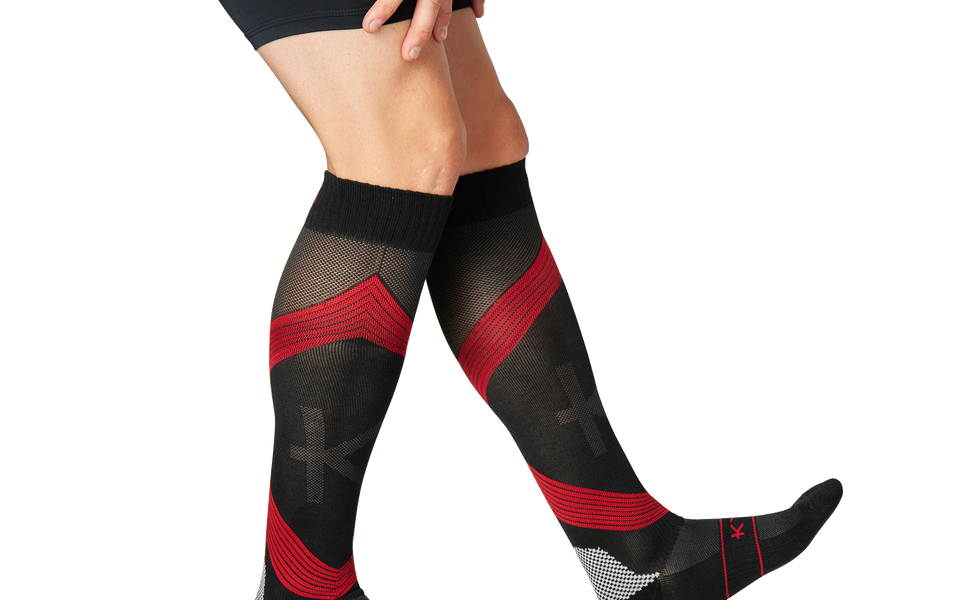In this article we're going to look at ways infrared fabrics can decrease the chance of deep vein thrombosis. We'll discuss the mechanisms by which the fabrics help reduce the chances of the condition, and how you can use KYMIRA Medical products to offset some of the risk.
We'll leave the article with suggestions for items that will help improve circulation and lower your DVT risk profile.
Time to read: 4 minutes
Key Points:
- What is Deep Vein Thrombosis?
- Infrared and DVT
- How compression wear helps with DVT
- The benefits of movement in DVT
- Infrared wear around the clock
- Conclusion
"If part of the clot breaks off and travels through the bloodstream it can cause problems in other areas such as the lungs."
Checkout our product rangeWhat is DVT?
Deep vein thrombosis is a condition where blood clots form in the blood vessels (usually in the legs). If part of the clot breaks off and travels through the bloodstream it can cause problems in other areas such as the lungs.
In extreme cases, DVT can be fatal, so you can understand why for those suspectable to the condition, deep vein thrombosis is a very real concern.
The good news is that you can help to avoid DVT by taking a few basic steps. It's a condition that is sometimes caused by lifestyle factors such as sedentary behaviour and long-distance travel (travel over 4 hours doubles the risk of developing DVT) [1]. Both reduce the rate of blood flow, so help to create the conditions whereby clots can form.
Here's how to help avoid DVT using infrared technology, even when you're travelling.
Compression and DVT
The official NHS advice regarding DVT and travel is to wear compression socks and move as often as possible [3]. The KYMIRA socks combine both the infrared technology with compression, so you get the best of both worlds. The evidence collected from other studies also recommend compression stockings for avoiding DVT when travelling [4].
If you know you're going to be embarking on a long journey – especially in the air, dress accordingly. If you're at a particularly high risk of deep vein thrombosis (over 60, smoker, obese etc) then it'd make sense to wear KYMIRA garments even on long car or train journeys.
How movement helps
Exercise is one of the most effective circulation boosters there is, so it comes as no surprise that the research around movement and reduction of DVT risk is strong [5]. You don't have to exercise to a particularly high intensity – especially if you're wearing the KYMIRA garments. The effects of the movement and the infrared compound, meaning there's additional benefit.
Simply going for a walk, a gentle bike ride, a gym workout etc are more than sufficient to raise the pulse rate, therefore improve your circulation and significantly reduce your risk of deep vein thrombosis.
Round the clock infrared wear
If you suffer with poor circulation, you will benefit from wearing infrared garments at all times of the day. We sell clothing for a wide range of uses, such as socks and gloves for the extremities (particularly useful if you suffer from conditions such as Raynaud's disease ), through to sportswear and even sleepwear.
Thanks to the passive nature of the technology, you don't need to do anything when it's on – just relax and let the infrared get to work.
Infrared and DVT
As we've learned from the research, improving blood flow and vasodilation are key factors when it comes to avoiding deep vein thrombosis. Infrared fabrics such as KYnergy are proven help with both. Simply by wearing KYMIRA garments you'll be taking significant and effective steps towards reducing your DVT risk.
Checkout KYMIRA product range Expand For References[1] https://www.ncbi.nlm.nih.gov/pmc/articles/PMC2020806/
[2] https://onlinelibrary.wiley.com/doi/full/10.1002/advs.201801122
[3] https://www.nhs.uk/conditions/deep-vein-thrombosis-dvt/
[4] https://www.ncbi.nlm.nih.gov/pmc/articles/PMC6457834/
